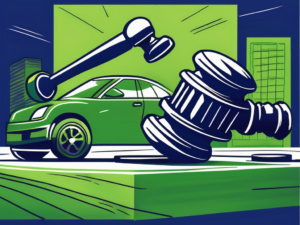Talk to Sales: (401) 200-6026

In today’s competitive automotive industry, effective marketing strategies are essential for businesses to thrive. A well-executed marketing plan can help automotive companies attract customers, build brand awareness, and ultimately increase their sales. In this ultimate guide to automotive marketing, we will explore the importance of automotive marketing and provide you with valuable tips and strategies to succeed in this dynamic industry.
Understanding the Basics of Automotive Marketing
In order to develop effective marketing strategies for the automotive industry, it is crucial to understand the basics of automotive marketing. Automotive marketing encompasses a wide range of activities aimed at promoting vehicles, auto parts, and related services. The primary goal is to reach and engage target customers in order to generate leads and drive conversions.
When it comes to automotive marketing, it is essential to recognize the importance of staying up-to-date with the latest industry trends and consumer preferences. By keeping a finger on the pulse of the market, automotive businesses can better understand their target audience and tailor their marketing efforts accordingly. This involves conducting thorough market research to identify emerging trends, consumer demands, and competitor strategies.
The Importance of Automotive Marketing
Automotive marketing plays a pivotal role in the success of automotive businesses. By implementing effective marketing strategies, companies can attract potential customers, differentiate themselves from competitors, and ultimately increase their market share. Additionally, marketing allows automotive companies to build brand loyalty and foster long-term relationships with customers, which is crucial for repeat business and customer referrals.
One of the key benefits of automotive marketing is its ability to create brand awareness. Through various advertising channels such as television, radio, print media, and digital platforms, automotive businesses can showcase their products and services to a wide audience. This exposure helps to establish brand recognition and familiarity, making it more likely for potential customers to choose their brand over competitors.
Key Elements of Automotive Marketing
A successful automotive marketing strategy comprises various key elements. These elements include market research, customer segmentation, branding, advertising, public relations, and customer relationship management. By carefully considering these elements and developing a comprehensive plan, automotive businesses can effectively target their customers and communicate their unique value propositions.
Market research is a critical component of automotive marketing as it provides valuable insights into consumer behavior, preferences, and market trends. By understanding the needs and desires of their target audience, automotive businesses can tailor their marketing messages and offerings to better resonate with potential customers.
Customer segmentation is another essential element of automotive marketing. By dividing the target market into distinct groups based on demographics, psychographics, and buying behaviors, automotive businesses can create more personalized and targeted marketing campaigns. This approach allows them to deliver the right message to the right audience, increasing the chances of customer engagement and conversion.
Branding is also a crucial aspect of automotive marketing. A strong and consistent brand identity helps automotive businesses differentiate themselves from competitors and build trust with customers. Through effective branding strategies, such as logo design, brand messaging, and brand positioning, automotive companies can establish a positive perception in the minds of consumers, influencing their purchasing decisions.
Advertising and public relations are vital tools in automotive marketing. Through strategic advertising campaigns, automotive businesses can reach their target audience through various channels, including traditional media and digital platforms. Public relations efforts, on the other hand, help to enhance the reputation and credibility of automotive brands through media coverage, press releases, and events.
Lastly, customer relationship management is an integral part of automotive marketing. By nurturing relationships with existing customers and providing exceptional customer service, automotive businesses can foster loyalty and encourage repeat business. This includes implementing customer retention strategies, such as loyalty programs, personalized communication, and post-purchase support.
In conclusion, understanding the basics of automotive marketing is essential for developing effective strategies in the automotive industry. By recognizing the importance of marketing, incorporating key elements, and staying abreast of industry trends, automotive businesses can successfully engage their target audience, build brand loyalty, and drive business growth.
Sell cars on the lot faster with AutoRaptor
Know if we’re the right fit within 10 minutes
Developing a Successful Automotive Marketing Strategy
Developing a successful automotive marketing strategy requires careful planning and consideration. In today’s competitive market, it is crucial for automotive businesses to stand out and effectively reach their target audience. Here are some key steps to get you started on creating a winning marketing strategy:
Identifying Your Target Audience
The first step in creating an effective automotive marketing strategy is to identify your target audience. Understanding the demographics, interests, and preferences of your ideal customers is essential for crafting tailored marketing messages that resonate with them. Conduct market research, analyze customer data, and gather insights to gain a deep understanding of your target audience. This will enable you to create compelling marketing campaigns that drive engagement and conversions.
For instance, if your target audience consists of young professionals who value sustainability, you can emphasize the eco-friendly features of your vehicles and highlight how your brand aligns with their values. On the other hand, if your target audience is families who prioritize safety, you can focus on showcasing the advanced safety technologies in your vehicles.
Setting Clear Marketing Goals
Before implementing any marketing activities, it is essential to set clear goals. Having well-defined objectives will guide your marketing efforts and help you measure success. Your goals may vary depending on your business objectives, but some common marketing goals for automotive companies include:
- Increase brand awareness
- Generate leads
- Boost sales
- Enhance customer loyalty
- Improve online presence
By setting specific, measurable, attainable, relevant, and time-bound (SMART) goals, you can ensure that your marketing strategy is focused and effective. For example, you can aim to increase brand awareness by 20% within six months or generate 100 qualified leads per month.
Choosing the Right Marketing Channels
There are numerous marketing channels available in the automotive industry, both traditional and digital. It is important to choose the channels that align with your target audience and marketing goals. Consider using a combination of online platforms, such as social media and search engine optimization (SEO), as well as traditional channels like print advertising, outdoor marketing, and radio or television advertising to maximize your reach and engagement.
When selecting the right marketing channels, it is crucial to understand where your target audience spends their time and how they prefer to consume information. For example, if your target audience consists of tech-savvy individuals who are active on social media, investing in social media marketing and influencer partnerships can be highly effective. On the other hand, if your target audience is older and more likely to consume traditional media, allocating resources towards radio or television advertising might yield better results.
Furthermore, leveraging data analytics and tracking tools can provide valuable insights into the performance of your marketing campaigns. By analyzing the data, you can identify which channels are driving the most engagement, leads, and conversions, allowing you to optimize your marketing strategy for maximum impact.
Remember, developing a successful automotive marketing strategy is an ongoing process. Continuously monitor market trends, consumer behavior, and competitor activities to stay ahead of the curve. Regularly evaluate and adjust your marketing efforts based on the results and feedback you receive. By staying agile and adaptive, you can ensure that your automotive marketing strategy remains effective and drives sustainable business growth.
Sell cars on the lot faster with AutoRaptor
Know if we’re the right fit within 10 minutes
Digital Marketing Tips for the Automotive Industry
In today’s digital age, leveraging digital marketing techniques is crucial for success in the automotive industry. With the increasing competition and rapidly evolving consumer behavior, it is essential to stay ahead of the game. Here are some essential tips to enhance your digital marketing efforts:
Utilizing Social Media Platforms
With billions of active users, social media platforms provide an excellent opportunity to connect with potential customers. In the automotive industry, social media platforms such as Facebook, Instagram, and Twitter can play a significant role in building brand awareness and engaging with your target audience.
When using social media for your digital marketing efforts, it’s important to create a consistent and compelling brand presence. Share valuable content related to your products and services, showcase customer testimonials, and provide updates on the latest industry trends. By actively engaging with your audience through comments, likes, and shares, you can build a loyal community of followers who are more likely to convert into customers.
The Power of SEO in Automotive Marketing
Search engine optimization (SEO) is vital for increasing your online visibility and driving traffic to your website. In the automotive industry, where competition is fierce, having a strong SEO strategy can make a significant difference in attracting potential customers.
Start by optimizing your website with relevant keywords that your target audience is likely to search for. Conduct thorough keyword research to identify the most popular and relevant terms. Then, strategically incorporate these keywords into your website’s meta tags, headings, and content.
In addition to keywords, creating engaging and valuable content is crucial for SEO success. Regularly publish blog posts, articles, and videos that provide useful information to your audience. This not only helps improve your search engine rankings but also positions your brand as a trusted authority in the automotive industry.
Building quality backlinks from reputable websites is another essential aspect of SEO. Reach out to industry influencers, bloggers, and journalists to secure guest posting opportunities or mentions of your brand. These backlinks will not only drive traffic to your website but also signal to search engines that your website is trustworthy and relevant.
Email Marketing in the Automotive Industry
Email marketing remains an effective strategy for automotive businesses to nurture leads, engage with customers, and promote their products and services. By creating personalized and targeted email campaigns, you can build relationships, drive conversions, and increase customer loyalty.
When implementing email marketing in the automotive industry, it’s important to segment your audience based on their preferences, behaviors, and demographics. This allows you to tailor your messages to specific groups, increasing the chances of engagement and conversion.
Consider sending out regular newsletters with updates on new vehicle models, special promotions, and maintenance tips. Additionally, leverage automation tools to send personalized follow-up emails to customers who have shown interest in specific vehicles or services.
Remember to provide value in your emails by including helpful tips, educational content, and exclusive offers. By consistently delivering valuable content to your subscribers, you can establish trust and credibility, making them more likely to choose your dealership when they are ready to make a purchase.
By implementing these digital marketing tips, you can enhance your online presence, attract more customers, and stay ahead of the competition in the automotive industry. Keep in mind that digital marketing is an ongoing process, so regularly analyze your results, adapt your strategies, and stay up-to-date with the latest trends to ensure long-term success.
Traditional Marketing Strategies in the Automotive Industry
While digital marketing has become increasingly prevalent, traditional marketing strategies still play a significant role in the automotive industry. Here are some effective traditional marketing techniques:
The Role of Print Advertising
Despite the rise of digital advertising, print advertising continues to be a powerful tool in the automotive industry. Print ads in newspapers, magazines, and classifieds can reach a wide audience and leave a lasting impression. Consider utilizing print advertising to target specific demographics and promote your latest vehicles or services.
Effective Outdoor Advertising Techniques
Outdoor advertising, such as billboards and vehicle wraps, can be highly impactful in capturing the attention of potential customers. By strategically placing your advertisements in high-traffic areas, you can generate awareness and increase brand visibility.
The Impact of Radio and Television Advertising
Radio and television advertising are traditional yet effective ways to reach a mass audience. By creating compelling audio or visual advertisements, you can engage listeners and viewers, generate interest in your products, and drive customers to your dealership or website.
By implementing a comprehensive marketing strategy that incorporates both traditional and digital techniques, automotive businesses can maximize their reach and impact. Remember, consistency, creativity, and continuous evaluation are key to staying ahead in the ever-evolving automotive marketing landscape. Start by understanding your target audience, setting clear goals, and utilizing the appropriate marketing channels. With the right strategies in place, your automotive business can thrive and conquer the competitive automotive industry.
Want to improve your sales and move cars off the lot faster? Book a test drive with AutoRaptor to see how our simple dealership CRM software can help you close more deals effectively.
Subscribe to our Newsletter
Resources to help your dealership convert more leads into sales, retain more customers, and market inventory smarter, straight to your inbox every Sunday.




